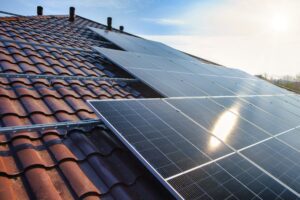Did you know that around 25% of a home’s heat is lost through an uninsulated roof? By insulating your loft, you can save money on your energy bills, cut back your carbon emissions, and improve your home’s EPC rating, while enjoying year-round warmth and comfort.
When properly installed, loft insulation can stay effective for at least 40 years, or more. Depending on the material you use and the state of your loft, the process can be quick, simple, and affordable. Some lofts can be insulated as a DIY project, while others require the help of a professional.
In this detailed guide, we’ll discuss the many benefits of proper loft insulation, the best types to choose from, and the different ways of installing them. We’ll also go over important safety measures, must-have tools and supplies, and key things to remember before insulating your loft.
What Is Loft Insulation?
Loft insulation is a thermal barrier that’s installed with the intention of retaining heat. It consists of layers of insulating material that prevent heat from rising through a property and escaping through the roof. Insulation for a loft space comes in various forms, including rolls, spray foam, boards, and granules.
Benefits of Loft Insulation
There are plenty of advantages that come with a well-insulated loft, including:
- Warmth and Comfort: Proper insulation acts like a blanket that slows down the passage of heat from your home to outside. It helps to regulate the temperature of your home, keeping you warm in winter, cool in summer, and comfortable all year round.
- Lower Energy Bills: You could save up to £340 a year on energy bills by insulating an uninsulated loft, according to the Energy Saving Trust (based on fuel price as of July 2024 and a totally uninsulated loft in a detached property having 270mm of loft insulation added). Correctly installed loft insulation will more than pay for itself in the form of savings on energy bills over its 40-year+ lifetime.
- Protects the Environment: With adequate insulation, your home will require less heating, increasing your energy efficiency and reducing your carbon footprint. As a result, your home will become much more environmentally friendly.
- Noise Reduction: Installing loft insulation helps to reduce the amount of noise pollution coming from the outside. Acoustic insulation allows you to enjoy more peace and quiet indoors, especially in the upper floors of your home.
- Enhanced Property Value: Loft insulation increases your home’s Energy Performance Certificate (EPC) rating, making it more attractive to buyers and potentially increasing its sale value. An insulated loft also gives you an edge over similar homes in the market.
Types of Loft Insulation Material
Your choice of insulation will affect the cost, lifespan, and performance of your loft insulation, as well as the method and duration of the installation process. The main types of loft insulation material often used to insulate a loft include blanket loft insulation, sheet insulation, blown-in insulation and the sometimes controversial spray foam insulation.
1. Batt, Roll, or Blanket Loft Insulation
Blanket insulation is a popular type of insulation that’s typically made from fibreglass, mineral fibre (rock and slag) wool, plastic fibres, or natural fibres, like sheep and cotton wool. It comes in the form of batts and rolls that are designed to fit into the joists, rafters, and trusses of your loft.
Loft insulation rolls are available in various widths and thicknesses. Some loft roll comes with special facings that act as a vapour or air barrier and have flame-resistant properties. Blanket insulation is simple to install, but depending on the type chosen, can be irritating to the eyes, skin, and respiratory system, so use with caution.
Blanket insulation, such as wool insulation, can take up a lot of loft space, as it may be necessary to install a second layer to reach the recommended levels of insulation. This can cause difficulty when trying to insulate a loft that has inaccessible small spaces or obstructions.
2. Sheet Insulation or Insulation Boards
Sheet insulation comes in the form of flat, rigid, and durable boards that offer a high insulating value per unit of thickness. The boards are compressed and resistant to pressure, making them ideal for loft conversions as well as roofs and lofts that need a hard surface for storing items.
Rigid insulation boards can be made from polystyrene, polyisocyanurate, or polyurethane. They’re available with a moisture-resistant or fire-resistant coating and can be covered with plasterboard for a decorative finish. You can order loft boarding pre-cut to your desired sizes.
3. Loose-Fill or Blown-In Insulation
Loose-fill or blown-in insulation is a lightweight form of insulation that consists of loose granules made from fibreglass, cellulose, or mineral wool. The granules are mechanically blown into position and can be used to fill up joist cavities or top up layers of existing insulation.
You can use loose-fill or blown fibre insulation in lofts that are difficult to access, as the granules can easily fit around obstructions and small spaces. Since it’s usually made of recycled materials, this insulation is eco-friendly. However, it’s not recommended for draughty lofts.
4. Spray Foam Insulation
Spray foam, also known as expanding foam or polyurethane foam, is a liquid insulation that’s made of two chemical products: polyol resin and isocyanate. The chemicals react when mixed together and expand in place to fill all of the available area, including the tiniest nooks and crannies.
Once the foam has set, it creates a solid and durable layer of insulation that also seals cracks and blocks moisture. This type of insulation — available as open-cell and closed-cell spray foam — is usually applied with a spray gun, and is often used for insulating roofs, lofts, and attics, especially those with inaccessible loft spaces.
However, it can be more expensive than other insulation materials, the application is messy, and it is not without issues for those who have had it installed, especially when it comes to trying to sell a property once it has been installed. Effective Home does not install spray foam, and nor do we recommend it.
Things to Consider Before Installing Loft Insulation
Here are a few essential tips and things to keep in mind before starting the loft insulation installation process:
Tools and Supplies Needed
To save time and energy, prepare your equipment, tools, and insulation material ahead of time. Depending on the type of insulation you choose, you might need a handsaw or utility knife, scissors, a staple gun, a screwdriver, duct tape, measuring tape, tacks, and a straight edge.
Calculate how much insulation you’ll need by measuring your entire loft area, including the spaces between the joists and the height of the joists as well. Note that current building regulations in the UK recommend a minimum depth of 270 mm for loft insulation.
Safety Measures
Don’t forget to wear protective clothing while working, including coveralls, knee pads, gloves, goggles, and a mask. Rubber-soled shoes are also important since they’ll allow you to feel the joists under your feet. You may also need a mobile workbench, work lights, and a rubble bag.
Always use crawling boards on your loft joists so that you can work safely and efficiently. The boards need to sit across three or more joists to spread your weight evenly. Stepping between the joists is a no-no because your foot might go through the ceiling or you may fall through.
Cold Loft vs. Warm Loft
Loft insulation can be installed over and between the joists, which are the horizontal beams along the floor of your loft. This keeps most of your home’s warmth contained in the living areas below, and produces a “cold loft.”
On the other hand, loft or roof insulation can also be applied on the rafters, the angled roof timber beams that support your roof. This allows you to keep your loft space insulated and therefore warmer, effectively creating a warm roof or “warm loft.” This approach is typically used for a loft conversion when you are planning on using the room for more than just storage space.
Insulating at rafter level is generally less efficient than insulating the loft floor as you need to heat a larger volume of air i.e. the space in the loft as well as the rest of the property.
Heat and Lighting Fixtures
If there are light fittings from the rooms below that protrude into your loft, you’ll need to cover them with downlight caps or downlight covers. The caps will enable air circulation around the light fittings to prevent them from overheating and creating a fire hazard.
Other safety considerations include heat-producing fixtures, like hot flues and chimneys. Avoid installing insulation in direct contact with them, and keep the insulation a minimum of 75 mm away.
Electrical Wires and Cables
If possible, electrical wiring should be placed on top of the insulation to reduce the risk of overheating and fire. Turn off the power at the main consumer unit before touching the wiring and never attempt to stretch them.
Asbestos Removal
If your home was originally built before the 2000s, it’s possible your loft space may have vermiculite insulation, a grey or brown pebble-like material that can contain asbestos. When inhaled, asbestos can cause severe health problems, and it has been associated with lung cancer.
If you suspect the presence of asbestos in your loft, you’ll need to have a trained professional assess and remove the vermiculite before you install new insulation.
How to Install Loft Insulation Using Batt or Roll Insulation
Batt or roll insulation, also known as blanket insulation, comes in rolls that can be hand-cut to fit in between joists and wall stud cavities. It works well in large and open spaces, including lofts. It’s affordable, effective, and easy to install blanket insulation, making it a popular choice for DIY projects.
However, if your loft is difficult to access, has damp problems, has a flat roof, or needs a complex insulation system, the Energy Saving Trust recommends hiring a professional installer.
Here’s how you can insulate your loft using batt or roll insulation:
- Prepare the Loft: Clear away any items and bits of debris in your loft, and ensure that it’s well-ventilated and free from condensation. If your loft doesn’t have a floor, prepare boards that you can crawl or kneel on while working. You may also need extra LED lights to see clearly.
- Measure and Cut the Rolls: After putting on protective clothing, measure your loft space and the distance between your loft joints. Without removing the packaging, mark the appropriate width on your insulation roll and cut it into strips that fit between the joists using a handsaw.
- Apply the Insulation: Starting from the furthest point from the loft hatch, roll out the first layer of insulation between your joists, the horizontal beams that form the floor of the loft. Lay down another layer at right angles on top of the joists to reach the required depth of insulation.
- Lightly Press and Fit The Rolls Snugly: This will prevent any gaps in your insulation. Avoid placing heavy objects on top of the rolls, because compressing them decreases their thermal efficiency.
- Insulate the Loft Hatch Door: Attach insulation to the inside of your loft hatch or door using a staple gun or tacks to prevent heat loss. Add draught-proof strips around the edges to prevent cold draughts from passing through the hatch.
- Insulate the Pipes and Water Tank: Insulating the joists will make your house warmer, but it’ll make the loft space above colder. To prevent the pipes and cold water tanks in your loft from freezing, you’ll need to insulate them by fitting some pipe insulation and using a tank jacket.
How to Install Loft Insulation Using Spray Foam
Installing spray foam insulation requires specialised equipment, technical expertise, and personal protective gear, to keep your skin and lungs safe. The installation must be done properly to avoid costly mistakes, health hazards, reduced efficiency, or damage to your home.
For these reasons, do-it-yourself spray foam installation isn’t recommended. If you are determined to proceed with spray foam insulation, it’s best to seek help from professional installers who are trained and equipped to apply spray foam to your loft safely, correctly, and in accordance with local building regulations. Effective Home does not install spray foam, nor do we recommended it.
The process of installing spray foam insulation in a loft typically includes the following steps:
- Home Survey: To ensure that spray foam insulation is suitable for your loft, an installer will visit to assess its size, structure, and energy efficiency, and to address any risks or problems.
- Clear the Loft: Your loft should be clear of clutter, debris, and pests before the installation begins. Place plastic sheets over areas you want to protect from dripping foam. Electrical fittings must be removed, and cracks must be sealed so that the insulation functions effectively.
- Safety and Compliance: Installers will wear personal protective equipment and maintain adequate ventilation in the loft to avoid health risks. They will also comply with building codes and help you secure any necessary permits beforehand.
- Application of Spray Foam: Using a specialised spray gun, the foam is evenly applied in multiple layers around the joist space or under the roof deck to fill all the gaps. Excess foam can be cut away using a carving tool or hand saw after the insulation has set.
- Clean Up and Monitoring: Installers will finish the remaining tasks, such as cleaning up the loft, removing plastic sheets, and monitoring the spray foam insulation’s performance.
How to Install Loft Insulation Using Insulation Boards
Insulation boards are one of the most widely used forms of insulation in the UK. There are two main methods of installing them: you can use adhesive bonding, also known as the “dot and dab” method, or you can use mechanical fixings, like wall plugs and wood screws.
The latter is ideal for loft insulation as it enables you to create air gaps between the loft surface and the insulation board. These gaps provide ventilation and prevent moisture buildup.
Here’s a step-by-step guide on how you insulation boards can be installed correctly in your loft :
- Prepare the Loft: Start by vacuuming dust and removing debris from your loft, sealing cracks, securing permits from the local authorities, and gathering your gear and supplies.
- Measure and Cut the Boards: You can add boards between the joists, over the joists, or both. Whichever you choose, measure the spaces where you plan to install the boards using a measuring tape and cut the boards to the correct sizes with a utility knife.
- Attach Timber Battens: If you decide to install the insulating boards within the joists, you’ll need to create a 50mm (2-inch) air gap by attaching timber battens of the same measurement, using a nail gun or a screwdriver. You can skip this if you prefer to install boards on top of the joists.
- Install the Boards: Secure the loft boarding onto the timber battens using drywall screws. Make sure that the screws penetrate at least 25mm into the battens for a sturdy and long-lasting hold. You can also install boards on top of the joists using a nail gun.
How to Install Loft Insulation Using Loose-Fill or Blown-In Insulation
Loose-fill or blown-in insulation is another good option for covering large spaces, including lofts. This type of insulation is usually blown into place using specialised machinery and a flexible tube that allows you to insulate tight spaces and hard-to-reach areas.
Although not recommended, loose-fill insulation can also be poured in. Much like spray foam, applying this insulation isn’t particularly DIY-friendly, so hiring professional installers is advised.
Here are the steps for installing loose-fill or blown-in insulation on your loft:
- Prepare the Loft: Remove belongings, debris, and other obstructions from your loft, check for air gaps, and ensure that the space is ready for insulation. Obtain the required permits for the installation and prepare your safety gear as well, including a mask, gloves, and coveralls.
- Set Up the Blower: Position the blower machine on a spot near the loft opening. Connect the hose to the blower and find an assistant to continuously feed loose fill insulation into its hopper. When you turn the blower switch on, it will introduce air to the insulation, causing it to expand.
- Apply the Insulation: Using the hose, start blowing in the insulation from the part of the loft that’s farthest from the hatch or the door, and work your way from there. Apply insulation parallel to the joists to fill up the cavities, but avoid blocking the vents, grills, or air bricks.
- Check the Insulation: Inspect your work to see if the insulation is adhering properly, and that all the areas that need insulation are evenly filled, including the edges of your loft. Move around carefully, and step from joist to joist to avoid falling through a weak spot in your ceiling.
Professional Loft Insulation at Effective Home
At Effective Home, we provide comprehensive loft insulation services that begin with a free, no-obligation home energy survey. Expect a quick, high-quality, and hassle-free installation, with our team of registered installers who have over 30 years of insulation experience.
Have peace of mind with our 25-year guarantee on all types of loft insulation, complemented by flexible payment options. Our experts will assist you every step of the way—from choosing the most suitable insulation for your loft space to leaving your home clean and tidy when it’s done.
Enjoy a warmer home, reduced heating bills, and an improved EPC rating with Effective Home. Get a quote today!



